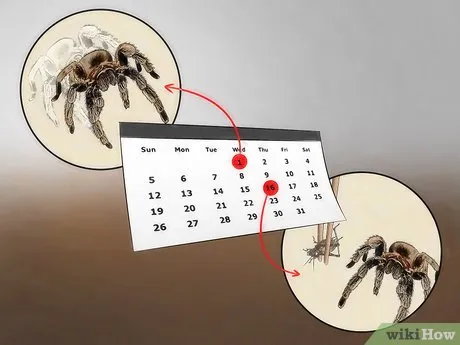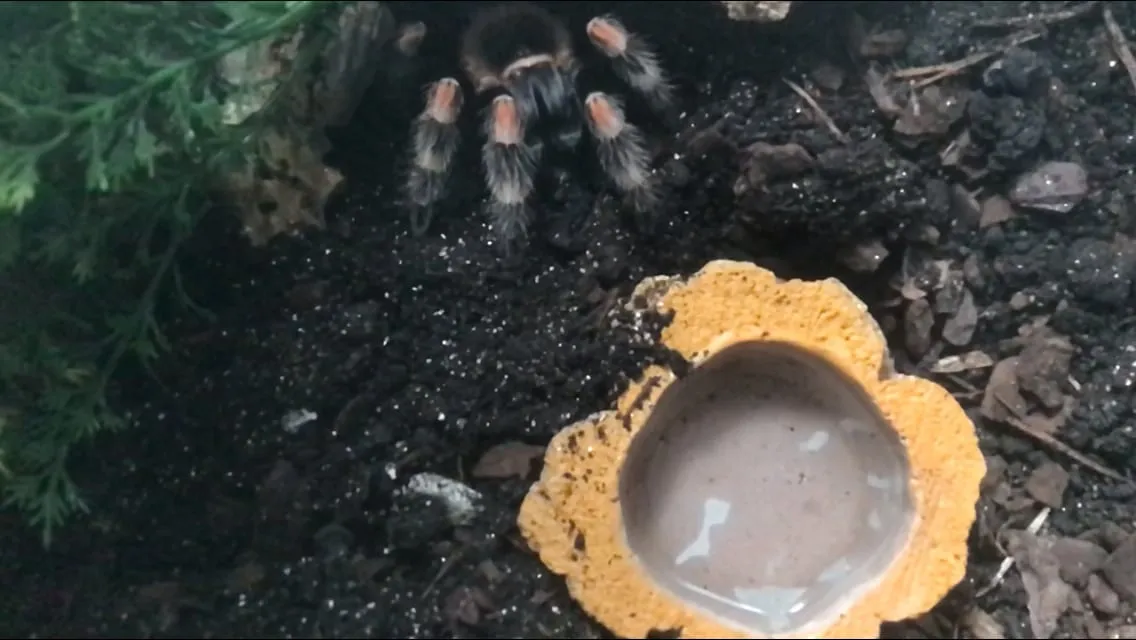Why Watch Tarantula Feeding in Slow Motion?
Watching tarantulas feed in slow motion offers a unique and captivating glimpse into the natural world. It allows us to appreciate the intricate details of their predatory behavior that are often missed by the naked eye. The slow-motion effect unveils the speed, precision, and power these creatures possess, transforming a simple act of feeding into a mesmerizing spectacle. Beyond the visual appeal, these videos also provide valuable insights into tarantula biology, helping us understand their hunting strategies, feeding mechanisms, and overall survival tactics. The slow-motion perspective allows us to study the biomechanics involved, from the initial strike to the ingestion of prey, providing an educational experience for both enthusiasts and scientists alike. By slowing down time, we gain a deeper appreciation for the wonders of nature and the extraordinary adaptations of these fascinating arachnids. Seeing a tarantula feeding slow motion is the closest we can get to seeing a tarantula in their natural habitat.
Understanding Tarantula Feeding Behavior
Tarantula feeding behavior is a complex and fascinating process. These spiders are ambush predators, primarily relying on their keen senses and lightning-fast reflexes to capture prey. They typically wait patiently for an unsuspecting insect or small animal to wander within striking distance. Once the prey is close enough, the tarantula launches a swift attack, using its fangs and chelicerae to immobilize the victim. The tarantula then injects venom, which serves to paralyze the prey and begin the process of pre-digestion. Digestive enzymes break down the prey’s internal organs, turning them into a liquid meal that the tarantula can then suck up. The entire feeding process can vary in duration depending on the size and type of prey, but slow-motion videos offer an unparalleled opportunity to observe the nuances of these behaviors. Understanding these feeding habits is crucial for responsible tarantula care, as it helps owners provide appropriate prey and create an environment that encourages natural behaviors.
The Mechanics of a Tarantula’s Strike

The tarantula’s strike is a marvel of natural engineering, combining speed, precision, and power. The spider’s body is perfectly adapted for this rapid movement, with strong legs and a flexible exoskeleton allowing for quick bursts of acceleration. The strike begins with a subtle shift in body position, followed by a rapid lunge towards the prey. The chelicerae, which house the fangs, are extended forward with incredible force. This motion is carefully coordinated, ensuring that the fangs accurately pierce the prey’s body, delivering the venom. The entire sequence, from the initial ambush to the fang penetration, often happens in a fraction of a second. Slow-motion videos provide an unprecedented view of this process, allowing us to analyze the intricate muscle movements and biomechanical principles that make the tarantula’s strike so effective. Studying these mechanics helps to appreciate the evolutionary adaptations that have made tarantulas successful predators for millions of years. This mechanism is a very interesting process to watch.
The Role of Chelicerae and Fangs
The chelicerae and fangs are the tarantula’s primary tools for capturing and subduing prey. The chelicerae are paired appendages located near the mouth, and they house the fangs, which are sharp, hollow structures. When the tarantula strikes, the fangs are driven into the prey, delivering a potent venom. This venom serves multiple purposes, including paralyzing the prey, initiating pre-digestion, and protecting the tarantula from potential harm. The size and shape of the fangs can vary depending on the tarantula species and its diet. Some species have longer, more curved fangs that are well-suited for piercing tough exoskeletons, while others have shorter, straighter fangs that are better for capturing softer prey. The slow-motion videos allow us to study the intricate movements of the chelicerae and fangs, providing a detailed look at how these structures function during feeding. The study of fangs and their use can help us better understand the behavior of this animal.
Top 5 Tarantula Feeding Slow Motion Videos
Video 1 A Goliath Birdeater Feast

Witness the immense power of the Goliath Birdeater, the world’s largest tarantula, as it devours its meal in slow motion. This video showcases the sheer size of the spider and the impressive speed and force with which it captures and consumes its prey. The Goliath Birdeater’s feeding habits are unique due to its size and ability to take down larger prey. It offers a rare insight into the feeding process of a giant spider. This video is a must-see for arachnid enthusiasts.
Video 2 The Chilean Rose Tarantula Strikes
Experience the striking elegance and efficiency of the Chilean Rose tarantula’s feeding behavior. This video highlights the spider’s agility and precision as it hunts and subdues its prey. The Chilean Rose tarantula, a popular pet, demonstrates its natural hunting abilities. The video shows how this adaptable species feeds in various environments. This video will allow you to admire the beauty of this tarantula.
Video 3 A Grammostola Feeding
Observe the feeding habits of a Grammostola tarantula in detail. The video shows the tarantula’s method of taking down its meal, including how it uses its fangs and chelicerae. The feeding style varies among Grammostola species. Slow-motion captures the details of this tarantula’s hunting skills. You will learn how these creatures feed using this video.
Video 4 The Arizona Blonde Tarantula Eats

See the Arizona Blonde tarantula in action as it feeds. The video illustrates the tarantula’s feeding process, showcasing its hunting style and the way it consumes its prey. This tarantula, known for its gentle nature, demonstrates its natural hunting skills. Watch this video to discover how the Arizona Blonde tarantula feeds.
Video 5 Slow Motion Feeding
Enjoy a compilation of various tarantula feeding behaviors captured in slow motion. This video offers a comprehensive look at the feeding habits of different tarantula species. See diverse feeding techniques and how different spiders approach their meals. This compilation is a great resource for anyone interested in these arachnids. This video offers the most information of the series.
Analyzing Tarantula Feeding Techniques
Analyzing tarantula feeding techniques involves observing the various methods and strategies these spiders employ to capture and consume their prey. Key factors include the speed and precision of the strike, the use of venom to paralyze the prey, and the process of pre-digestion. Some tarantulas may use a ‘sit-and-wait’ approach, remaining motionless until prey comes within striking distance, while others actively stalk their victims. The way a tarantula handles its prey, from the initial grab to the final meal, reveals a great deal about the species’ adaptations and survival strategies. Slow-motion videos offer valuable data for this analysis, allowing researchers and enthusiasts to study the nuances of these behaviors in detail. This information is not only fascinating but also essential for understanding tarantula care and conservation.
Prey Selection and Preparation

Prey selection is a critical aspect of a tarantula’s feeding habits. Tarantulas typically feed on insects, such as crickets, mealworms, and roaches, but some larger species may also consume small vertebrates, such as mice and lizards. The size and type of prey depend on the tarantula’s size, age, and the availability of food in its natural habitat. Before consuming their prey, tarantulas may prepare it in several ways. They may use their chelicerae to crush the prey’s exoskeleton, inject venom to immobilize it, and then begin the pre-digestion process. Slow-motion videos show these processes in detail, revealing the intricate ways tarantulas adapt to different prey types. Providing the correct prey type and size is essential to keep a pet tarantula healthy. Learning about prey selection is essential for caring for tarantulas.
Optimal Feeding Frequency and Amounts
The optimal feeding frequency and amount for a tarantula depend on factors such as its age, species, and overall health. Young tarantulas typically require more frequent feedings compared to adults, as they are actively growing. It is important not to overfeed tarantulas, as this can lead to health problems. The frequency of feeding varies based on the species and how often they molt. Providing an appropriate amount of food and avoiding overfeeding helps maintain the tarantula’s health. Monitor your tarantula’s feeding habits, health, and appearance to adjust feeding schedules accordingly. These factors are important to understand for those owning this animal.
Common Feeding Challenges and Solutions
Tarantula owners may encounter various feeding challenges, such as refusal to eat, picky eating habits, or difficulties with prey capture. Several factors can contribute to these issues, including stress, environmental conditions, illness, and incorrect prey selection. If a tarantula is not eating, it may be due to stress, molting, or changes in its environment. Providing appropriate humidity, temperature, and hiding places can help reduce stress. Ensuring that the prey is the appropriate size and type can encourage feeding. If a tarantula consistently refuses to eat, it is best to consult with an experienced tarantula keeper or veterinarian. Understanding these common challenges and implementing appropriate solutions is vital to keeping a tarantula healthy and content. Taking the right actions can help overcome these challenges.
